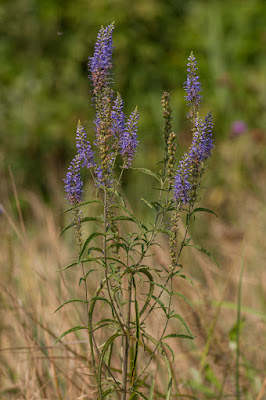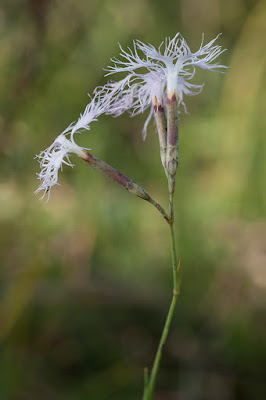The wet meadows of the Daru Mire of Álmosd in the southernmost part of the Nyírség Region are remnants of the postglacial period, when former river valleys were closed by sand dunes. It has many relict plants of cooler eras. It is located next to the even wetter Mire of Kokad and both are parts of the Kék Kálló Valley Natura 2000 area. Location: Mire of Álmosd. Date: 08-09.2015.
Die Feuchtwiesen des Daru Moors von Kokad im südlichsten Teil der Nyírség Region formen einen Restbestand des postglazialen Zeitraum, in dem ehemalige Flusstäler von Sanddunen abgeschlossen wurden. Das Moor besitzt eine Pflanzenwelt mit vielen Kaltzeitrelikten. Es liegt neben dem noch feuchteren Moor von Kokad und beide sind Anteile des Kék-Kálló Tal Natura 2000 Gebietes. Ort: Moor von Álmosd. Datum: 08-09.2015.
Az Álmosdi Daru-láp láprétjei a Nyírség legdélebbi részén a posztglaciális időszak maradványai, melyben az egykori folyómedreket homokdűnék zárták el. Növényviláguk számos hidegkori reliktum miatt ismert. Az állandó vízborítottságú Kokadi Daru-láp mellett helyezkednek el; mindkettő a Kék-Kálló Völgye Natura 2000 terület része. Hely: Álmosdi Daru-láp. Dátum: 2015.08-09.
The Daru Mire at Álmosd:
Das Daru Moor bei Álmosd:
Az álmosdi Daru-láp:
Marsh Fern (Thelypteris palustris):
Sumpffarn (Thelypteris palustris):
Tőzegpáfrány (Thelypteris palustris):
Silver Birch (Betula pendula):
Weiß-Birke (Betula pendula):
Közönséges nyír (Betula pendula):
The characteristic, very tall subspecies of the common nettle(Urtica dioica subsp. subinermis):
Ufer-Brennnessel, eine charakteristische hochwachsende Unterart der Großen Brennnessel (Urtica dioica subsp. subinermis):
A nagy csalán jellegzetes, nagyon magasra növő alfaja (Urtica dioica subsp. subinermis):
Longleaf Speedwell (Pseudolysimachion longifolium subsp. longifolium):
Langblättriger Ehrenpreis (Pseudolysimachion longifolium subsp. longifolium):
Hosszúlevelű fürtösveronika (Pseudolysimachion longifolium subsp. longifolium):
Hosszúlevelű fürtösveronika (Pseudolysimachion longifolium subsp. longifolium):
Fringed Pink (Dianthus superbus subsp. superbus):
Prachtnelke (Dianthus superbus subsp. superbus):
Buglyos szegfű (Dianthus superbus subsp. superbus):
Tumbleweeds of field eryngo (Eryngium campestre):
Bodenläufer des Feld-Mannstreus (Eryngium campestre):
Mezei iringó (Eryngium campestre) ördögszekerei:
Meadowsweet (Filipendula ulmaria subsp. ulmaria):
Echtes Mädesüß (Filipendula ulmaria subsp. ulmaria):
Réti legyezőfű (Filipendula ulmaria subsp. ulmaria):
Great Burnet (Sanguisorba officinalis):
Großer Wiesenknopf (Sanguisorba officinalis):
Őszi vérfű (Sanguisorba officinalis):

The protected Marsh Gentian (Gentiana pneumonanthe) is rare in the lowlands:
Der geschützte Lungen-Enzian (Gentiana pneumonanthe) kommt auf Flachland selten vor:
A védett kornistárnics (Gentiana pneumonanthe) ritka az Alföldön:
European Bugleweed (Lycopus europaeus subsp. mollis):
Ufer-Wolfstrapp (Lycopus europaeus subsp. mollis):
Vízi peszérce (Lycopus europaeus subsp. mollis):
European goldenrod (Solidago virgaurea):
Gewöhnliche Goldrute (Solidago virgaurea):
Közönséges aranyvessző (Solidago virgaurea):
Devil's-Bit (Succisa pratensis):
Gewöhnlicher Teufelsabbiss (Succisa pratensis):
Réti ördögharaptafű (Succisa pratensis):
Queen Anne's Thistle (Cirsium canum):
Graue Kratzdistel (Cirsium canum):
Szürke aszat (Cirsium canum):

Common Tansy (Tanacetum vulgare subsp. vulgare):
Rainfarn (Tanacetum vulgare subsp. vulgare):
Gilisztaűző varádics (Tanacetum vulgare subsp. vulgare):
The rare Autumn Ox-eye (Leuceanthemella serotina):
Die seltene Herbstmargerite (Leuceanthemella serotina):
A ritka tisza-parti margitvirág vagy kései margitvirág (Leuceanthemella serotina):
Praying Mantis (Mantis religiosa):
Europäische Gottesanbeterin (Mantis religiosa):
Imádkozósáska (Mantis religiosa):
Hungarian Ground Beetle (Carabus (Pachystus) hungaricus hungaricus):
Ungarischer Laufkäfer (Carabus (Pachystus) hungaricus hungaricus):
Magyar futrinka (Carabus (Pachystus) hungaricus hungaricus):
A thrips on the Devil's Bit:
Blasenfuß auf dem Teufelsabbiss:
Tripsz az ördögharaptafűről:
Old World Swallowtail (Papilio machaon gorganus) caterpillar:
Schwalbenschwanz (Papilio machaon gorganus) Raupe:
Fecskefarkú lepke (Papilio machaon gorganus) hernyója:
Steatoda castanea spider:
Steatoda castanea Spinne:
Steatoda castanea pók:
Galls of the gall mite Aceria laticincta on loosestrife:
Gallen der Gallmilbe Aceria laticincta auf Gilbweiderich:
Aceria laticincta gubacsatka gubacsa lizinkán:
Common Stinkhorn (Phallus impudicus):
Gemeine Stinkmorchel (Phallus impudicus):
Erdei szömörcsög (Phallus impudicus):
Bovista sp puffball:
Eine Boviste (Bovista sp):
Bovista sp pöfeteg:
Slate Bolete (Leccinum duriusculum):
Pappel-Raufuß (Leccinum duriusculum):
Nyárfa érdestinóru (Leccinum duriusculum):





























































No comments:
Post a Comment